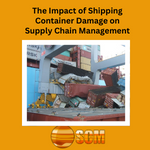Shipping containers are an essential element of the global supply chain, facilitating the transportation of goods across vast oceans and continents. However, the condition of these containers is often overlooked despite its significant impact on the safety and efficiency of shipments. This article aims to delve into the effects of container damage and provide valuable insights on mitigating risks to ensure smooth operations.


The Importance of Shipping Container Condition in Supply Chain Management:
Maintaining the condition of shipping containers is paramount to successful supply chain management. Damaged containers can result in delays, loss of goods, and even safety hazards. Regular inspection and maintenance of containers are necessary to guarantee their structural integrity and secure transportation of goods. Furthermore, investing in high-quality containers helps minimize the risks associated with damage, ultimately contributing to the seamless functioning of the supply chain.
Types of Container Damage and their Impact on Supply Chain Efficiency:
Various types of container damage can significantly affect supply chain efficiency. For instance, external dents and scratches compromise structural integrity and can lead to leaks or safety hazards. Damage to locking mechanisms or door seals makes it challenging to secure containers properly and safeguard transported goods. Timely inspection and prompt resolution of such damage are crucial to avoid disruptions in the supply chain.
Strategies for Mitigating Container Damage and Improving Supply Chain Performance:
Mitigating container damage is imperative for ensuring a smooth and efficient supply chain. Investing in high-quality containers, less susceptible to damage, is one effective strategy. Regular inspections and maintenance practices help identify and address potential issues before they escalate. Additionally, implementing proper loading and unloading procedures, including the use of appropriate equipment and secure cargo handling, can prevent damage during transportation. By adopting these measures, overall supply chain performance can be enhanced, and disruptions caused by container damage can be minimized.
The Role of Technology in Container Monitoring and Maintenance:


Technology plays a pivotal role in container monitoring and maintenance. Sensors installed in containers enable real-time monitoring of factors such as temperature, humidity, and other environmental conditions that may affect the cargo. This data can be transmitted to a central system, facilitating proactive maintenance and repairs. Software applications can also track container movements, identifying potential issues such as delays or damage. Leveraging technology empowers supply chain managers to improve visibility and control over containers, reducing the risk of damage and enhancing overall efficiency.
Best Practices for Managing Container Damage and Ensuring a Smooth Supply Chain:
Effective management of container damage is vital to maintaining a smooth supply chain. Regular inspections before and after each shipment are crucial for early detection of damage or potential issues, allowing for timely repairs or replacements. Partnering with reliable and experienced logistics providers who prioritize container maintenance and implement rigorous quality control measures is another best practice. Finally, investing in technology such as sensors and software enhances visibility and control over container movements, thereby reducing the risk of damage and improving overall efficiency.
Key Statistics and Tables:
[Table 1: Types of Container Damage and their Impact on Supply Chain Efficiency]
| Type of Damage | Impact on Supply Chain Efficiency |
| External dents | Compromised structural integrity |
| Scratches | Increased risk of leaks |
| Damaged locks/seals | Inadequate cargo protection |
[Table 2: Strategies for Mitigating Container Damage and Improving Supply Chain Performance]
| Strategies | Impact |
| Invest in high-quality containers | Minimize susceptibility to damage |
| Regular inspections and maintenance | Identify and address potential issues proactively |
| Implement proper loading and unloading procedures | Prevent damage during transportation |
| Leverage technology | Enhance visibility and control over container movements |
Shipping container damage poses significant challenges to supply chain management, potentially resulting in delays, loss of goods, and safety hazards. To mitigate these risks and ensure smooth operations, it is vital to prioritize container condition through regular inspections, maintenance, and investment in high-quality containers. Technology, including sensors and software, plays a crucial role in monitoring and maintaining containers, improving visibility and control over movements. By implementing best practices and partnering with reliable logistics providers, supply chain managers can optimize container management, minimize disruptions, and enhance overall supply chain efficiency.
Check out our blog for more logistics insights, tips and news


